Australia’s transition to clean energy is heavily reliant on the development of innovative energy storage solutions, as emphasized in a recent white paper from Monash Business School. The report, authored by Associate Professor Guillaume Roger, underlines the importance of storing renewable energy to meet the country’s ambitious energy targets. With goals like reducing emissions by 43% and increasing renewable energy generation to 82% by 2030, the need for effective energy storage solutions is more critical than ever.
One of the key challenges highlighted in the white paper is the management of intermittent energy sources like solar and wind. The report points out that the current trading methods and financial support mechanisms in place do not adequately address the unique requirements posed by renewable energy and its storage. To overcome these obstacles, significant policy reforms are needed to ensure that renewable energy is not only generated but also utilized according to real-time demand.
Experts agree that implementing large-scale energy storage solutions is urgent to realize the vision for clean energy in Australia. Without these solutions, the progress towards clean energy goals may be hindered. The white paper suggests various policy recommendations aimed at reforming how energy is managed and traded within the National Electricity Market (NEM). These reforms include measures like Locational Marginal Pricing (LMP) and establishing day-ahead markets (DAMs) to improve grid efficiency and ensure reliability.
In addition to policy reforms, incentivizing investment in storage infrastructure is crucial to ensure the reliability of grid systems. The report suggests re-evaluating existing programs like the Capacity Investment Scheme (CIS) to encourage maximum utilization of storage capabilities. By developing new frameworks and promoting forward contracting, the aim is to enhance price signals and increase overall grid efficiency.
The recent increase in renewable energy usage is a positive sign of progress, with around 12% of Australia’s grid now relying on renewable energy sources. Corporate participation in renewable energy agreements is also growing, with high-profile advocates like Andrew Forrest pushing for real decarbonization efforts. Initiatives like the Renewable Energy Guarantee of Origin (REGO) framework aim to align renewable generation with demand through time stamping and incentives for concurrent consumption.
Companies like Flow Power are at the forefront of integrating consumer behavior with renewable energy usage. By offering technologies that allow customers to monitor and adjust their consumption patterns to match production peaks, they are maximizing the use of renewable energy. This integration is especially crucial as the adoption of electric vehicles increases household electricity demands.
The Federal Government’s Capacity Investment Scheme (CIS) is another initiative aimed at supporting Australia’s electricity market’s future. By targeting the identification of dispatchable capacity, the scheme seeks to boost renewable energy generation and storage capabilities. Initiatives like the third tender for 4GW of dispatchable capacity reflect the growing need for long-term investments in renewable energy infrastructure.
Overall, the push for greener energy solutions is gaining momentum in Australia, with collaborative efforts from policymakers, corporations, and the public. By prioritizing energy storage and renewable generation, the country is on track to achieve its clean energy goals. The systemic overhaul of the energy sector is not only timely but essential for building a sustainable future and shifting the narrative around energy storage and renewable energy generation.
